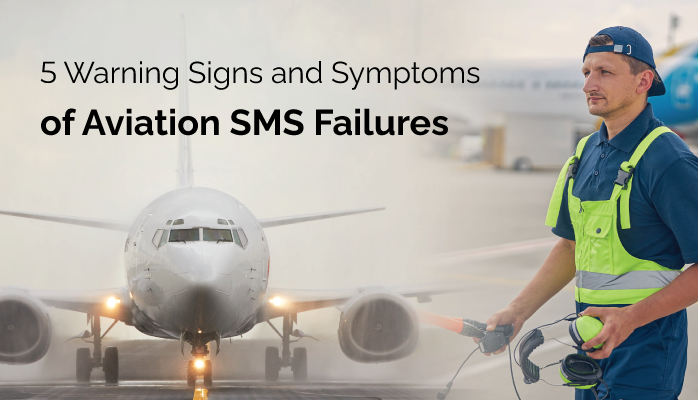Aviation Safety Management System Symptoms and Underlying Causes

An aviation safety management system (SMS) functions almost like a living, breathing entity. The SMS' required safety assurance processes facilitate improvements through continual verification and follow-up actions. Regardless of your SMS maturity level, the SMS continually evolves.
Every SMS has many moving parts that work together to reduce risk and comply with regulatory requirements. These individual components can exhibit healthy signs, as well as symptoms of underlying problems.
A lot of money and lives depend on a safety manager’s ability to recognize such signs and symptoms. Is your SMS experiencing any of these warning signs?
When you analyze symptoms in your aviation SMS, you have to consider three things:
- What a particular symptom means for safety;
- The underlying cause of each symptom your SMS suffers from; and
- What a combination of symptoms means for your SMS?
Related Aviation Risk Management Articles
- All Corrective Preventative Actions Not Created Equal: Initial Mitigating Actions
- What Is Risk Mitigation in Aviation SMS
- The 5 Risk Mitigation Strategies in Aviation SMS
The underlying cause remains the most worrisome. Management is tasked with sniffing out underlying or “symptomatic” problems in their SMS. Here are 5 symptoms indicating your safety management system could be in big trouble.
1 – Repeat Safety Incidents
Regardless of your aviation industry segment, similar safety issues will arise every now and then. This phenomenon appears in airlines, aviation maintenance organizations, airports, and yes, even FBOs.
Repeat safety incidents are expected every now and then; however, there are times when these repeat events become unacceptable as Human Error is a part of the workplace. When we refer to repeat safety incidents, we are talking about:
- The same safety issues refuse to go away, despite diligent risk mitigation strategies;
- The same safety issue keeps being reported by employees; and
- Repeat safety issues with consistently aggravated risk levels (rather than going down).
When the same issue recurs endlessly, necessary steps are not being taken to avoid the issue and/or mitigate the severity. This risk management failure happens within one or more of the following three areas of your aviation SMS:
- SMS: risk controls do not effectively address the safety concern (i.e., an inadequate procedure);
- Employees: front line workers are not exhibiting desired safety behavior; or
- Management: safety issues are not being effectively managed to as low as reasonably practical (ALARP).
A serious problem exists with any of these scenarios, but more importantly, what implications can one draw about your aviation SMS' ability to practice risk management? Whenever the same issue continues to surface, it shows that the state of your current SMS cannot meet your organization’s safety needs.
In short – something needs to change quickly.
2 – Safety Issues and Corrective Actions Are Often Past Due

Now is a great time to check in on an extremely important pair of leading key performance indicator (KPI) metrics:
- Percent of issues closed on time;
- Percent of corrective preventative actions (CPAs) closed on time;
These two metrics are the epitome of measuring efficient risk management in aviation safety programs. When these percentages are high, management is responding to assigned safety issues quickly. Consequently, operational hazards and risks are being mitigated quickly to reduce risk to ALARP.
When these KPI percentages are low:
- Identified hazards and risks remain a danger to aviation-related operations;
- Management’s "response ability" performance is low; and/or
- Symptomatic deep-rooted problems exist, such as lack of management support or resistance to the SMS program.
Every non-performing aviation SMS remains a financial and physical liability to the entire aviation industry.
Related Monitor Aviation Safety Performance Articles
- 4 Tips to Monitor Employee Safety Performance in Aviation SMS
- How to Conduct Safety Performance Monitoring and Measurement
- Monitor Aviation SMS Contributing Factors
3 – Still Using Spreadsheets for Aviation Safety Database
As a professional database designer, let me point out a couple of sincere concerns about using spreadsheets for any kind of aviation safety database. From personal experience with programs like Excel, I can say that the lack of checks and controls for data entered into such spreadsheets easily leads to the following problems:
- Redundancy: the same data appears in multiple “sheets” or on multiple computers, and if you change one piece of data you have to manually change it everywhere;
- Inconsistency: data and formatting can quickly become wildly disorganized;
- Data security: It’s difficult to grant controls to who can access the spreadsheets, or to control how they are handled on your servers;
- Performance limitations: spreadsheets simply don’t even come close to being able to perform the complex data analysis that professional aviation SMS databases do;
- Sustainability: spreadsheets are cumbersome and practically impossible to generate timely reports that are useful to management to reduce risk to ALARP;
- Effective trend monitoring: since spreadsheet data must be aggregated and kept up to date across multiple organizational divisions and departments, it becomes very difficult to process trend reports when you have to "beg and wait" for data.
Long story short, the reason spreadsheets are a bad sign is that they are a ticking time bomb. I’ve seen it happen all too often. At some point, one of the above points is going to cause a problem. Maybe that problem will be an irritating setback. Maybe it will be a catastrophic blow to your aviation operating certificate. When auditors cannot quickly find documentation (proof) of an SMS or any indication of continuous improvement, you can be assured of one thing: audit findings.
Even more to the point, having an automated safety database is increasingly becoming a necessity in the aviation industry. If you can’t easily retrieve and manipulate complex data, such as SMS leading indicators, to improve your SMS, you will fall behind and earn more regulatory SMS audit findings. It’s inevitable.
Related Aviation SMS Articles
- 3 Things to Know before Buying Aviation SMS Database
- 7 Signs You Should Invest in an Aviation Safety Management Database
- See How Spreadsheet Not EASA Compliant Aviation Hazard Reporting Database
4 – Safety Incidents Are Not Being Reported through Prescribed System
This might be a scenario some of you are personally familiar with in your safety programs. When safety issues are not being managed through the prescribed channels, it’s usually because of one manager who:
- Is resistant to either the safety program or the technology required by the SMS;
- Wants the program to depend on him/her (because of insecurity about the position in the company);
- Would rather deal with things “under the table” to avoid looking bad; or
- Fears future retaliation because of the availability (or lack of) relevant safety data, such as lawsuits or regulatory actions.
These situations are common and unacceptable. The aviation industry as a whole has made flying the safest mode of transportation on the planet because of creating a prescribed system of doing things.
When managers undercut the safety program by dealing with things themselves (internally and undocumented), they reduce safety levels that predates the history of aviation safety management systems. In short, it’s about 20x riskier.
More Related Aviation SMS Articles
- Overcoming Resistance to Change through Transparency in Aviation SMS
- Checklist to Quantify Resistance to Your Aviation SMS
- How to Reduce Resistance to Aviation SMS Programs with Difficult Employees
5 – High Employee Turnover Rates

Employee turnover rates provide great leading indicator metrics. Plain and simple, employees who are new to your company or new to their position pose a much greater risk than experienced employees. Some metrics you need to know are:
- What is the average length of employment for front-line workers in your company?
- What percent of front-line employees have less than 5 years of experience at their job? Less than 5 years experience at your company?
- What percent of front-line employees have more than 5 years of experience at your company?
High employee turnover rates are symptomatic of several troubling problems with your organization:
- Toxic work environment (i.e. teamwork or relationships);
- Too much pressure to perform;
- Cronyism and corporate culture; and
- Undervalued employees.
So it’s not just the risk posed by new employees that is troublesome, but the underlying causes of the scenario are a major red flag.
Final Thoughts on Failing SMS
I hope we have given you some food for thought. Symptoms and warnings outlined above are useful for periodic review. Why? Because as we stated at the beginning, an SMS continually evolves. As time passes, the SMS changes, just as the operating environment changes.
Safety assurance processes are designed to keep your SMS on track and functioning as designed. A good hazard reporting solution will only work if your safety team continues to promote safety and demonstrate how important employee feedback is to the SMS and stakeholder's continued safety.
An SMS is a system of inter-working components or pillars. They are all important. When you neglect one pillar, you are inadvertently introducing risk into your operations. Remain vigilant.
Do you have any other symptoms or warnings to share? Please share in the comments below.
Are you interested in improving your proactive performance? Download our free list of 40 leading indicators, which are the hallmark of data-driven risk management.
Last updated July 2023.




